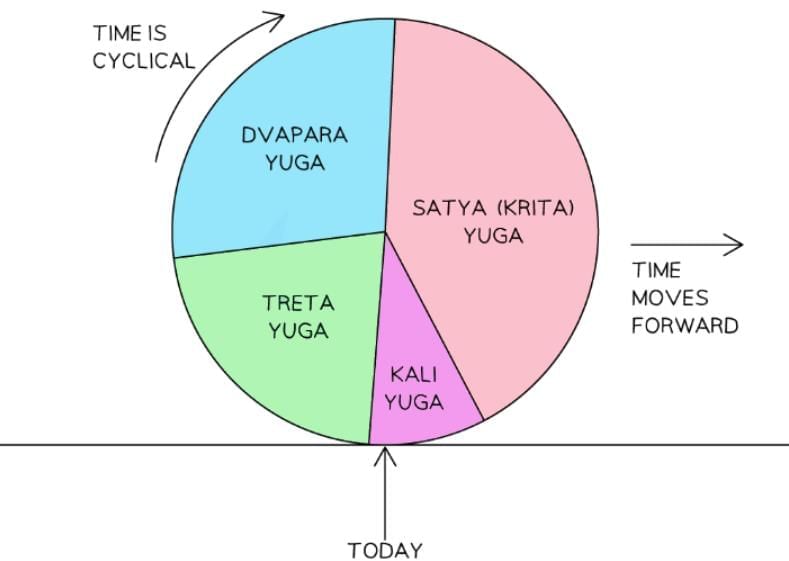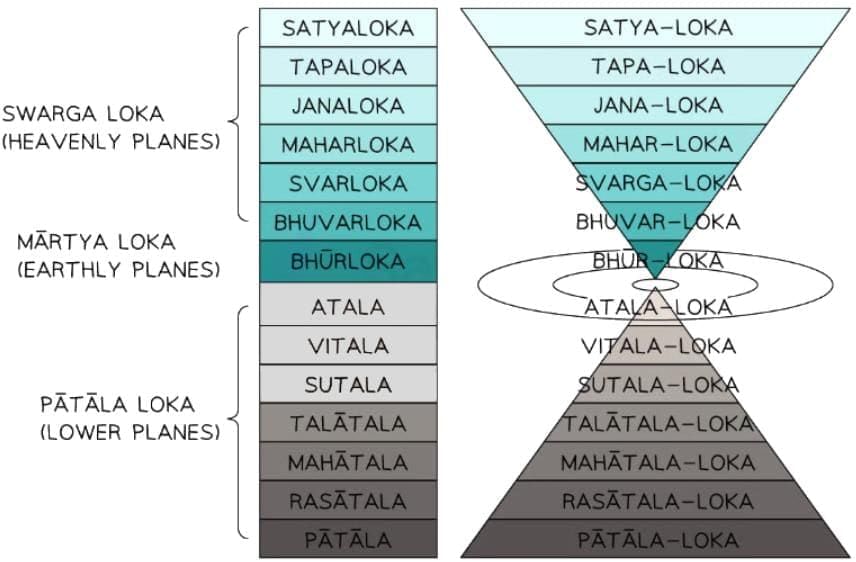The Cycle of the Four Ages | Religion, Philosophy & Ethics for GCSE/IGCSE - Year 11 PDF Download
The Cycle of the Four Ages
The Four Ages
In Hindu cosmology, time is divided into four extensive epochs known as yugas, collectively spanning 4,320,000 years. These yugas form a single cycle, each with distinct characteristics:
- Satya Yuga: The first age, marked by purity and righteousness.
- Treta Yuga: The second age, where virtue begins to decline.
- Dwapara Yuga: The third age, with further erosion of moral values.
- Kali Yuga: The fourth and current age, considered the most corrupt and shortest.
Each successive yuga is shorter in duration and believed to exhibit increasing moral and spiritual decline. Many Hindus believe we are currently in the Kali Yuga. These yugas represent stages of evolution, encompassing not only physical development but also mental and spiritual growth. The progress or regression of humanity in these aspects depends on the collective actions of each generation.
Hindus believe that at the conclusion of the Kali Yuga, Lord Vishnu will manifest as Kalki, his tenth avatar, riding a white horse. Kalki will eradicate the remaining evil, paving the way for a new golden age, restarting the cycle of yugas.
Meaning of the Four Ages
Some Hindus interpret the four yugas as symbolic of the stages in which humanity gradually loses connection with its inner self and physical body. Another perspective views the yugas as reflecting the progressive decline of righteousness in the world:
- Satya Yuga: An era where truth alone prevailed.
- Treta Yuga: The universe lost one-quarter of its truth.
- Dwapara Yuga: Half of the truth was lost.
- Kali Yuga: Only one-quarter of truth remains, with evil and dishonesty increasingly replacing truth over the last three ages.
The Universe
The Creation of the Universe
According to Hindu belief, the universe was created by Brahma, the creator deity, who formed it from his own essence. After Brahma’s act of creation, Vishnu, the preserver, sustains the universe and its inhabitants. As part of the cosmic cycle of birth, life, and death, Shiva, the destroyer, will ultimately bring the universe to an end. Brahma will then initiate the process of creation anew.
Brahma, Vishnu, and Shiva are considered manifestations of Brahman, the ultimate reality. Time in Hinduism is not linear but cyclical, with universes undergoing eternal cycles of creation, existence, and destruction, followed by recreation. This cyclical nature mirrors the Hindu concept of reincarnation.
Hindus envision the universe as clusters of bubbles floating in space, formed from the breath of Vishnu. Each universe contains three realms:
- Upper Realm: Heavenly planets inhabited by divine beings.
- Earthly Realm: The world of humans, including Earth.
- Lower Realm: A domain populated by less benevolent beings.
Every form of creation has a place within these realms, and with each cycle of life, individuals may transition to different realms based on their karma.
Hindu Creation Stories
Hinduism encompasses various narratives about the universe’s origin, reflecting its diverse philosophical traditions:
- One popular story describes a lotus flower emerging from Vishnu’s navel, with Brahma seated upon it. Brahma divided the lotus into three parts, creating the heavens, Earth, and sky. Feeling lonely, Brahma split himself into male and female forms, from which all beings originated.
- Another account speaks of an enormous cosmic egg that cracked open, giving birth to the universe and all life within it.
- The Hymn of Creation in the Rig Veda reflects on the mystery of creation, suggesting that no one, not even Brahman, may fully understand how the universe came to be.
- Some Hindu texts provide a more scientific perspective, describing the evolution of primary elements from a singular source.
These stories, originating in or around ancient India centuries ago, are not always intended as literal truths but serve as profound reflections on the complex and infinite nature of the universe.
Many Worlds
The Hindu Multiverse
Many Hindus believe in a multiverse comprising 14 lokas, or worlds, each inhabited by various beings. These lokas are categorized into two groups: seven upper worlds (vyarthis) and seven lower worlds (patalas).
The Seven Vyarthis (Upper Worlds)
- Satya-loka: The abode of Brahma, where the atman (soul) of individuals is liberated from the cycle of rebirth.
- Tapa-loka: Home to Ayohnija devadasis, divine beings.
- Jana-loka: Inhabited by the sons of Brahma.
- Mahar-loka: Residence of enlightened beings, such as the sage Markandeya.
- Svar-loka: The heavenly realm between the Sun and the Polar Star, ruled by Indra, where the 330 million Hindu gods reside.
- Bhuvar-loka (Pitri-loka): The space between Earth and the Sun, inhabited by semi-divine beings.
- Bhur-loka: Earth, considered one of billions of inhabited worlds in the universe.
The Seven Patalas (Lower Worlds)
- Atala-loka: Ruled by Bala, a son of Maya, who possesses mystical powers.
- Vitala-loka: Governed by Hara-Bhava, a form of Shiva.
- Sutala-loka: The kingdom of the demon king Bali.
- Talatala-loka: The realm of Maya, where Shiva resides under Maya’s protection.
- Mahatala-loka: Home to numerous nagas (serpents).
- Rasatala-loka: Inhabited by the demons Danavas and Daityas.
- Patala-loka (Naga-loka): The lowest realm, ruled by Vasuki, the king of serpents.

|
172 docs|3 tests
|
FAQs on The Cycle of the Four Ages - Religion, Philosophy & Ethics for GCSE/IGCSE - Year 11
| 1. What are the Four Ages in the Cycle of the Four Ages? |  |
| 2. How does the concept of Many Worlds relate to the Cycle of the Four Ages? |  |
| 3. What historical or philosophical significance do the Four Ages hold? |  |
| 4. Can the Cycle of the Four Ages be applied to modern society? |  |
| 5. How do different cultures interpret the Cycle of the Four Ages? |  |















